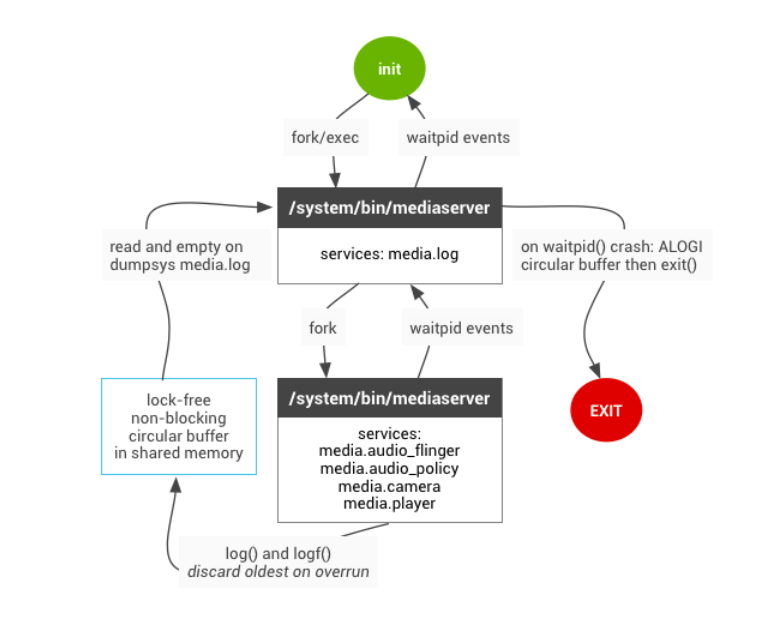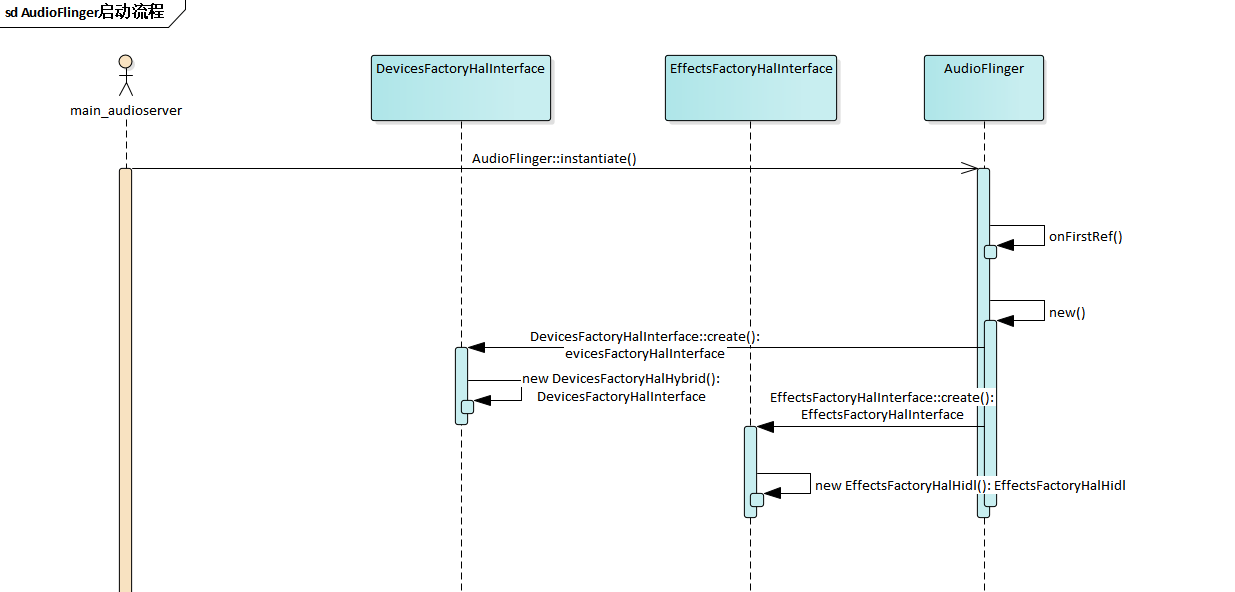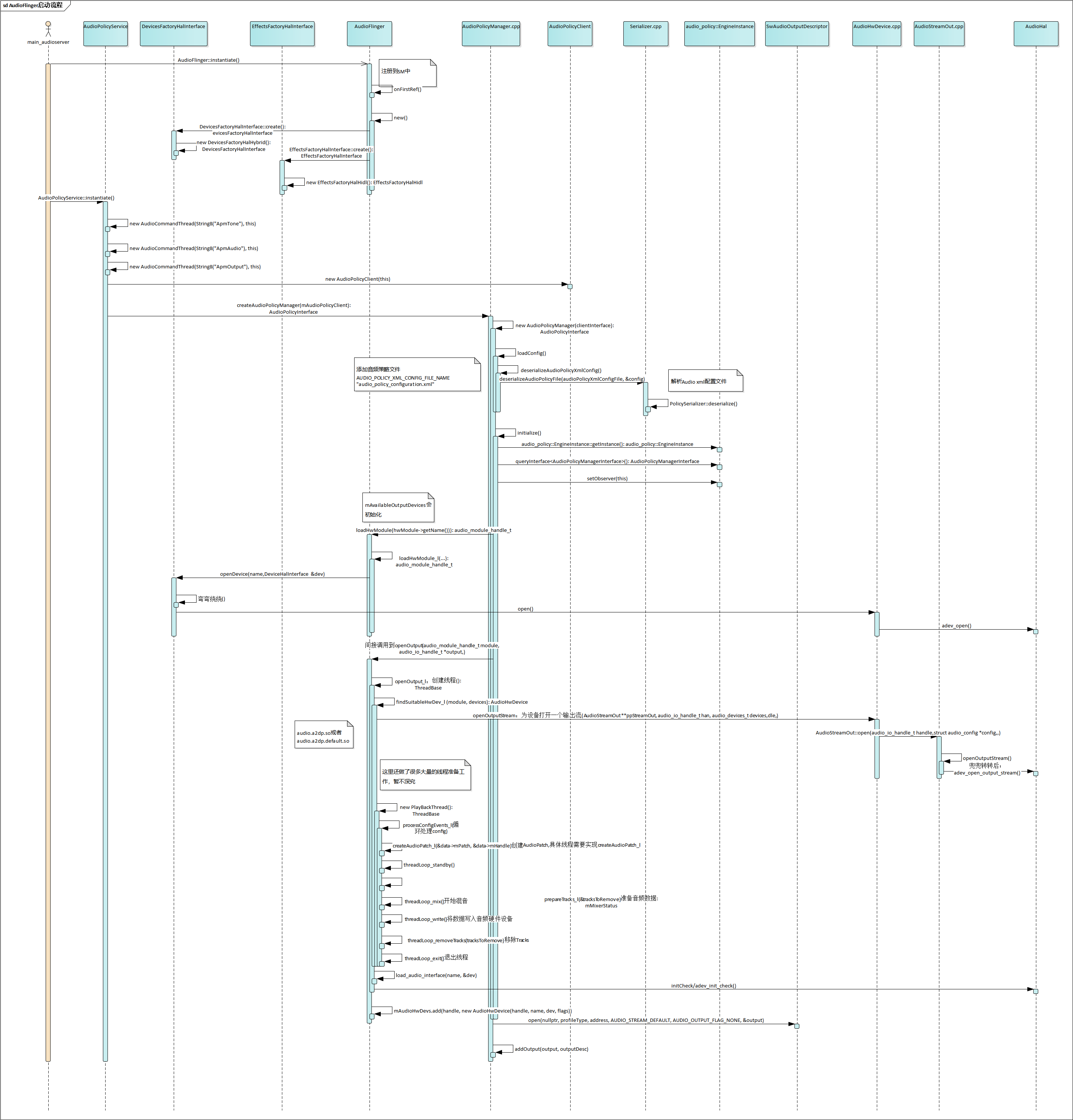- 1解决openai调用出现的valueerror: unknown scheme for proxy url url(‘socks://127.0.0.1:7890/‘)_raise valueerror(f"unknown scheme for proxy url {u
- 2回溯算法 深度优先搜索(dfs)_dfs算法怎么回溯
- 3怎么在Web3中创建智能合约_web3智能合约
- 4MySQL-成本与统计数据学习_成本分析与数据库
- 5【路径规划】基于matlab GUI多种蚁群算法栅格地图最短路径规划【含Matlab源码 650期】_蚁群算法栅格法
- 6PTT培训5分钟演讲
- 7机器学习面试:维特比算法_维特比算法的作用
- 8人工智能大模型原理与应用实战:对话系统构建_ai对话大模型 建设
- 9猿代码超算实习生,五步助力拿到高薪offer_猿代码网络科技公司面试
- 10布局香港之零售小店篇 | 香港一人小企与连锁超市的竞争
Android P Audio系统笔记:AudioPolicy&AudioFlinger初始化
赞
踩
AudioPolicy&AudioFlinger初始化
- 初始化概览
- 总体框架
- 启动步骤
- AudioPolicy初始化分析
- 1、loadConfig()
- 2、initialize()
初始化概览
总体框架
AudioFlinger和AudioPolicy两者是Android Audio框架层最主要的两个服务,他们两个是Android框架层的本地服务,在init.rc中启动;
AudioPolicyManager负责音频策略定制者,说白了就相当于Audio系统的司令。
AudioFlinger负责与底层audio alsa进行交互的实现者,那么它就是Audio系统的军官,干苦力的;
总体框架:
两个服务都属于audioserver进程,严格意义上来说audioserver通过init进程fork出来的,所以它是Linux系统中的一个进程。
AudioFlinger:media.audio_flinger
AudioPolicyService:media.audio_policy

启动步骤
1、通过init进程fork出来,从而开始各自服务的初始化
2、首先初始化audioflinger服务
3、其次初始化audiopolicyservice服务
4、进一步通过audiopolicyservice和audioflinger完成音频hal层的初始化,这部分将是本文的重点难点分析。
1、通过init进程fork出来,从而开始各自服务的初始化
来,看下它是怎么定义:
- //frameworks/av/media/audioserver/audioserver.rc
- service audioserver /system/bin/audioserver
- class core
- user audioserver
- onrestart restart audio-hal-2-0
- ioprio rt 4 //设置io优先级
- disabled
可以看到audioserver属于core类型,优于一般的main类型,也就是说它的启动是更早的。
audioflinger&audiopolicyserver启动:
- frameworks/av/media/audioserver/main_audioserver.cpp
- int main(int argc __unused, char **argv)
- {
- ---
- android::hardware::configureRpcThreadpool(4, false /*callerWillJoin*/);
- sp<ProcessState> proc(ProcessState::self());
- sp<IServiceManager> sm = defaultServiceManager();
- ALOGI("ServiceManager: %p", sm.get());
- AudioFlinger::instantiate();
- AudioPolicyService::instantiate();
- ---
- }
2、首先初始化audioflinger服务
AudioFlinger初始化比较简洁,就是创建服务并将自身注册到systemserver中去,其次就是初始化部分通信组件以便后续与audio hal层进行通讯。如下图所示:

3、其次初始化audiopolicyservice服务
AudioPolicyService的初始化就比audioflinger服务初始化复杂了,下图仅仅是audiopolicyservice与audiopolicymanager的初始化。主要就是创建出几个线程(AudioCommandThread类型的线程),以便后续与上层进行交互使用,上层调用的比如播放暂停的操作指令会进入这个线程队列,实现上层异步调用也可以防止底层耗时操作导致阻塞上层应用。接着便是创建AudioPolicyManager实例以及客户端等。大概流程如下图所示:

4、进一步通过audiopolicyservice和audioflinger完成音频hal层的初始化,这部分将是本文的重点难点分析。
audiopolicyservice启动后,开始创建audiopolicymanager,并通过audiopolicymanager初始化audiopolicy策略,然后再进行对audio路由引擎(EngineInstance)进行初始化,初始化完路由引擎后便对audio hal 的so进行加载初始化,进一步通过加载后的so针对音频设备进行open操作,并默认打开主通道的输出音频流,最后将成功初始化的音频设备进行保存到audiopolicymanager以及audioflinger中,最后完成初始化。
详细的初始化流程如下图所示:

AudioPolicy初始化分析
从上面的初始大概流程可以知道,audio框架的初始化重点在audiopolicy部分的初始化,它不仅需要初始音频策略,还需针对加载的音频策略针对hal层的音频设备进行初始化,这部分还涉及到audioflinger部分,但以audiopolicy作为主线进行分析,下面将一步步对其进行分析。
- //frameworks/av/services/audiopolicy/managerdefault/AudioPolicyManager.cpp
- AudioPolicyManager::AudioPolicyManager(AudioPolicyClientInterface *clientInterface)
- : AudioPolicyManager(clientInterface, false /*forTesting*/)
- {
- //1、加载audiopolicy的策略文件
- loadConfig();
- //2、针对加载的策略进行真正的初始化
- initialize();
- }
可以看到AudioPolicyManager构造函数很简单,就两个调用:loadConfig(),initialize();
1、loadConfig()
很简单,就通过配置文件USE_XML_AUDIO_POLICY_CONF来控制是使用XML配置的策略文件还是使用传统旧config配置文件。这个变量的初始化可以通过配置文件进行选择。
- //frameworks/av/services/audiopolicy/managerdefault/AudioPolicyManager.cpp
- void AudioPolicyManager::loadConfig() {
- #ifdef USE_XML_AUDIO_POLICY_CONF
- if (deserializeAudioPolicyXmlConfig(getConfig()) != NO_ERROR) {
- #else
- if ((ConfigParsingUtils::loadConfig(AUDIO_POLICY_VENDOR_CONFIG_FILE, getConfig()) != NO_ERROR)
- && (ConfigParsingUtils::loadConfig(AUDIO_POLICY_CONFIG_FILE, getConfig()) != NO_ERROR)) {
- #endif
- ALOGE("could not load audio policy configuration file, setting defaults");
- getConfig().setDefault();
- }
- }
其会通过Serializer.cpp进行XML文件的解析,这个是一个很繁重的任务,如需讲明其解析过程还需另起一个篇幅才能将其介绍,与初始化关系不大,一笔带过。
XML的配置文件格式如下(简化版配置):
- //frameworks/av/services/audiopolicy/config/audio_policy_configuration.xml
- <audioPolicyConfiguration version="1.0" xmlns:xi="http://www.w3.org/2001/XInclude">
- <globalConfiguration speaker_drc_enabled="true"/>
- <modules>
- <module name="primary" halVersion="2.0">
- <attachedDevices>
- <item>Speaker</item>
- </attachedDevices>
- <defaultOutputDevice>Speaker</defaultOutputDevice>
- <mixPorts>//输出混音线程
- <mixPort name="primary output" role="source" flags="AUDIO_OUTPUT_FLAG_PRIMARY">
- <profile name="" format="AUDIO_FORMAT_PCM_16_BIT" samplingRates="48000"
- channelMasks="AUDIO_CHANNEL_OUT_STEREO"/>
- </mixPort>
- </mixPorts>
- <devicePorts>//输出设备节点
- <devicePort tagName="Speaker" type="AUDIO_DEVICE_OUT_SPEAKER" role="sink" >
- </devicePort>
- </devicePorts>
- <routes>
- //音频路由
- <route type="mix" sink="Speaker" sources="esai output,primary output"/>
- </routes>
- </module>
- </modules>
- </audioPolicyConfiguration>

2、initialize()
好了,上面的都是开胃菜,这个才是硬菜。
来,看下这个大概步骤,心中有谱,码海不慌。
主要是三个步骤:
2.1初始音频路由引擎
audio_policy::EngineInstance *engineInstance = audio_policy::EngineInstance::getInstance();
2.2、加载so 并且打开设备节点
mpClientInterface->loadHwModule(hwModule->getName())
2.3、打开输出流
status_t status = outputDesc->open(nullptr, profileType, address, AUDIO_STREAM_DEFAULT, AUDIO_OUTPUT_FLAG_NONE,&output);
怕你不信,所以贴了部分代码出来:
- status_t AudioPolicyManager::initialize() {
- //1、初始音频路由引擎
- // Once policy config has been parsed, retrieve an instance of the engine and initialize it.
- audio_policy::EngineInstance *engineInstance = audio_policy::EngineInstance::getInstance();
- if (!engineInstance) {
- ALOGE("%s: Could not get an instance of policy engine", __FUNCTION__);
- return NO_INIT;
- }
- // Retrieve the Policy Manager Interface
- mEngine = engineInstance->queryInterface<AudioPolicyManagerInterface>();
- if (mEngine == NULL) {
- ALOGE("%s: Failed to get Policy Engine Interface", __FUNCTION__);
- return NO_INIT;
- }
- mEngine->setObserver(this);
- status_t status = mEngine->initCheck();
-
- for (const auto& hwModule : mHwModulesAll) {
- //2、加载so 并且打开设备节点
- hwModule->setHandle(mpClientInterface->loadHwModule(hwModule->getName()));
- mHwModules.push_back(hwModule);
- // open all output streams needed to access attached devices
- // except for direct output streams that are only opened when they are actually
- // required by an app.
- // This also validates mAvailableOutputDevices list
- for (const auto& outProfile : hwModule->getOutputProfiles()) {
- //经过一系列有效判断后 创建输出相关参数
- sp<SwAudioOutputDescriptor> outputDesc = new SwAudioOutputDescriptor(outProfile,
- mpClientInterface);
- const DeviceVector &supportedDevices = outProfile->getSupportedDevices();
- const DeviceVector &devicesForType = supportedDevices.getDevicesFromType(profileType);
-
-
- String8 address = devicesForType.size() > 0 ? devicesForType.itemAt(0)->mAddress
- : String8("");
- audio_io_handle_t output = AUDIO_IO_HANDLE_NONE;
- //3、打开输出流
- status_t status = outputDesc->open(nullptr, profileType, address,
- AUDIO_STREAM_DEFAULT, AUDIO_OUTPUT_FLAG_NONE, &output);
-
- if (status != NO_ERROR) {
- ALOGW("Cannot open output stream for device %08x on hw module %s",
- outputDesc->mDevice,
- hwModule->getName());
- } else {
- for (const auto& dev : supportedDevices) {
- ssize_t index = mAvailableOutputDevices.indexOf(dev);
- // give a valid ID to an attached device once confirmed it is reachable
- if (index >= 0 && !mAvailableOutputDevices[index]->isAttached()) {
- //这个很重要的变量,保存了可用的输出设备,后续会进一步说明
- mAvailableOutputDevices[index]->attach(hwModule);
- }
- }
- if (mPrimaryOutput == 0 &&
- outProfile->getFlags() & AUDIO_OUTPUT_FLAG_PRIMARY) {
- mPrimaryOutput = outputDesc;
- }
- addOutput(output, outputDesc);
- setOutputDevice(outputDesc, profileType, true, 0, NULL, address);
- }
- }//end inner for
- }//end out for
- }
- // make sure all attached devices have been allocated a unique ID



